2018 Hyundai Kona tyre pressure
[x] Cancel search: tyre pressurePage 380 of 497

6-18
What to do in an emergency
Changing a tyre with TPMS
If you have a flat tyre, the low Tyre
Pressure and Position telltales will
come on. We recommend that the
system be checked by a HYUNDAI
authorised repairer.
Each wheel is equipped with a tyre
pressure sensor mounted inside the
tyre behind the valve stem. You must
use TPMS specific wheels. It is rec-
ommended that you have your tyres
serviced by a HYUNDAI authorised
repairer.If you drive the vehicle for about 10
minutes at speeds above 15.5 mph
(25 km/h) after replacing the low
pressure tyre with the spare tyre, the
below will happen:
• The TPMS malfunction indicator
may blink for approximately 1 minute
and then remain continuously illumi-
nated because the TPMS sensor is
not mounted on the spare wheel.
You may not be able identify a tyre
with low pressure by simply looking
at it. Always use a good quality tyre
pressure gauge to measure the
tyre's inflation pressure. Please note
that a tyre that is hot (from being
driven) will have a higher pressure
measurement than a tyre that is cold
(from sitting stationary for at least 3
hour and driven less than 1 mile (1.6
km) during that 3 hour period).
Allow the tyre to cool before measur-
ing the inflation pressure. Always be
sure the tyre is cold before inflating
to the recommended pressure.
A cold tyre means the vehicle has
been sitting for 3 hours and driven for
less than 1 mile (1.6 km) in that 3
hour period.
•The TPMS malfunction indicator
may blink for approximately 1
minute and then remain contin-
uously illuminated if the vehicle
is moving around electric power
supply cables or radios trans-
mitter such as at police stations,
government and public offices,
broadcasting stations, military
installations, airports, or trans-
mitting towers, etc. This can
interfere with normal operation
of the Tyre Pressure Monitoring
System (TPMS).
•The TPMS malfunction indica-
tor may blink for approximately
1 minute and then remain con-
tinuously illuminated if snow
chains are used or some sepa-
rate electronic devices such as
notebook computer, mobile
charger, remote starter or nav-
igation etc., are used in the
vehicle.
This can interfere with normal
operation of the Tyre Pressure
Monitoring System (TPMS).
CAUTION
NEVER use a puncture-repair-
ing agent to repair and/or inflate
a low pressure tyre. The tyre
sealant can damage the tyre
pressure sensor. If used, you
will have to replace the tyre
pressure sensor.
CAUTION
Page 381 of 497

6-19
What to do in an emergency
6
•The TPMS cannot alert you to
severe and sudden tyre dam-
age caused by external factors
such as nails or road debris.
•If you feel any vehicle instabil-
ity, immediately take your foot
off the accelerator, apply the
brakes gradually and with
light force, and slowly move to
a safe position off the road.
WARNING
Tampering with, modifying, or
disabling the Tyre Pressure
Monitoring System (TPMS) com-
ponents may interfere with the
system's ability to warn the driv-
er of low tyre pressure condi-
tions and/or TPMS malfunctions.
Tampering with, modifying, or
disabling the Tyre Pressure
Monitoring System (TPMS) com-
ponents may void the warranty
for that portion of the vehicle.
WARNING
For EUROPE
•Do not modify the vehicle; it
may interfere with the TPMS
function.
•The wheels on the market do
not have a TPMS sensor.
For your safety, we recom-
mend that you use parts for
replacement from a HYUNDAI
authorised repairer.
•If you use the wheels on the
market, use a TPMS sensor
approved by a HYUNDAI
authorised repairer. If your
vehicle is not equipped with a
TPMS sensor or TPMS does
not work properly, you may
fail the periodic vehicle
inspection conducted in your
country.
❈All vehicles sold in the
EUROPE market during below
period must be equipped with
TPMS.
- New model vehicle :Nov. 1, 2012 ~
- Current model vehicle : Nov. 1, 2014~ (Based on
vehicle registrations)WARNING
Page 386 of 497
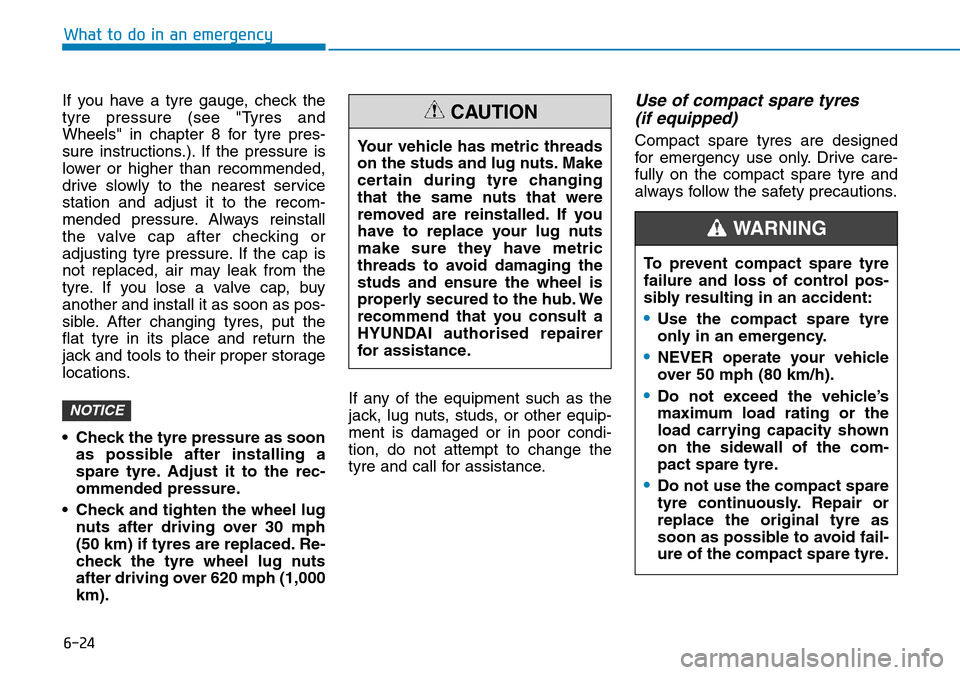
6-24
What to do in an emergency
If you have a tyre gauge, check the
tyre pressure (see "Tyres and
Wheels" in chapter 8 for tyre pres-
sure instructions.). If the pressure is
lower or higher than recommended,
drive slowly to the nearest service
station and adjust it to the recom-
mended pressure. Always reinstall
the valve cap after checking or
adjusting tyre pressure. If the cap is
not replaced, air may leak from the
tyre. If you lose a valve cap, buy
another and install it as soon as pos-
sible. After changing tyres, put the
flat tyre in its place and return the
jack and tools to their proper storage
locations.
• Check the tyre pressure as soon as possible after installing a
spare tyre. Adjust it to the rec-
ommended pressure.
• Check and tighten the wheel lug nuts after driving over 30 mph
(50 km) if tyres are replaced. Re-
check the tyre wheel lug nuts
after driving over 620 mph (1,000
km). If any of the equipment such as the
jack, lug nuts, studs, or other equip-
ment is damaged or in poor condi-
tion, do not attempt to change the
tyre and call for assistance.
Use of compact spare tyres
(if equipped)
Compact spare tyres are designed
for emergency use only. Drive care-
fully on the compact spare tyre and
always follow the safety precautions.
NOTICE
Your vehicle has metric threads
on the studs and lug nuts. Make
certain during tyre changing
that the same nuts that were
removed are reinstalled. If you
have to replace your lug nuts
make sure they have metric
threads to avoid damaging the
studs and ensure the wheel is
properly secured to the hub. We
recommend that you consult a
HYUNDAI authorised repairer
for assistance.
CAUTION
To prevent compact spare tyre
failure and loss of control pos-
sibly resulting in an accident:
•Use the compact spare tyre
only in an emergency.
•NEVER operate your vehicle
over 50 mph (80 km/h).
•Do not exceed the vehicle’s
maximum load rating or the
load carrying capacity shown
on the sidewall of the com-
pact spare tyre.
•Do not use the compact spare
tyre continuously. Repair or
replace the original tyre as
soon as possible to avoid fail-
ure of the compact spare tyre.
WARNING
Page 387 of 497
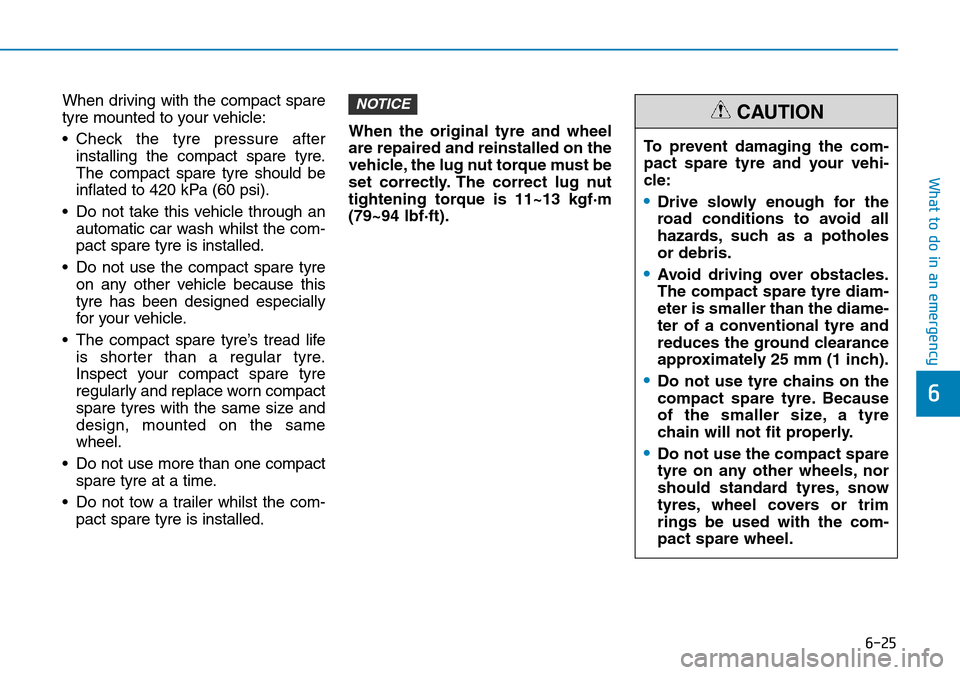
6-25
What to do in an emergency
6
When driving with the compact spare
tyre mounted to your vehicle:
• Check the tyre pressure afterinstalling the compact spare tyre.
The compact spare tyre should be
inflated to 420 kPa (60 psi).
• Do not take this vehicle through an automatic car wash whilst the com-
pact spare tyre is installed.
• Do not use the compact spare tyre on any other vehicle because this
tyre has been designed especially
for your vehicle.
• The compact spare tyre’s tread life is shorter than a regular tyre.
Inspect your compact spare tyre
regularly and replace worn compact
spare tyres with the same size and
design, mounted on the same
wheel.
• Do not use more than one compact spare tyre at a time.
• Do not tow a trailer whilst the com- pact spare tyre is installed. When the original tyre and wheel
are repaired and reinstalled on the
vehicle, the lug nut torque must be
set correctly. The correct lug nut
tightening torque is 11~13 kgf·m
(79~94 lbf·ft).NOTICE
To prevent damaging the com-
pact spare tyre and your vehi-
cle:
•Drive slowly enough for the
road conditions to avoid all
hazards, such as a potholes
or debris.
•Avoid driving over obstacles.
The compact spare tyre diam-
eter is smaller than the diame-
ter of a conventional tyre and
reduces the ground clearance
approximately 25 mm (1 inch).
•Do not use tyre chains on the
compact spare tyre. Because
of the smaller size, a tyre
chain will not fit properly.
•Do not use the compact spare
tyre on any other wheels, nor
should standard tyres, snow
tyres, wheel covers or trim
rings be used with the com-
pact spare wheel.
CAUTION
Page 390 of 497
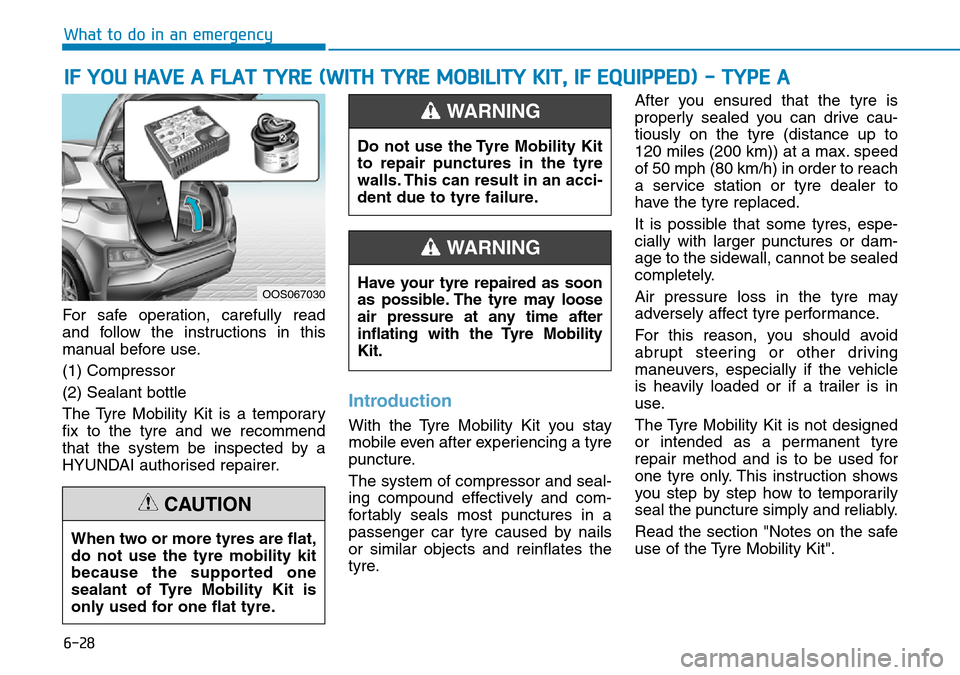
6-28
What to do in an emergency
For safe operation, carefully read
and follow the instructions in this
manual before use.
(1) Compressor
(2) Sealant bottle
The Tyre Mobility Kit is a temporary
fix to the tyre and we recommend
that the system be inspected by a
HYUNDAI authorised repairer.
Introduction
With the Tyre Mobility Kit you stay
mobile even after experiencing a tyre
puncture.
The system of compressor and seal-
ing compound effectively and com-
fortably seals most punctures in a
passenger car tyre caused by nails
or similar objects and reinflates the
tyre. After you ensured that the tyre is
properly sealed you can drive cau-
tiously on the tyre (distance up to
120 miles (200 km)) at a max. speed
of 50 mph (80 km/h) in order to reach
a service station or tyre dealer to
have the tyre replaced.
It is possible that some tyres, espe-
cially with larger punctures or dam-
age to the sidewall, cannot be sealed
completely.
Air pressure loss in the tyre may
adversely affect tyre performance.
For this reason, you should avoid
abrupt steering or other driving
maneuvers, especially if the vehicle
is heavily loaded or if a trailer is in
use.
The Tyre Mobility Kit is not designed
or intended as a permanent tyre
repair method and is to be used for
one tyre only. This instruction shows
you step by step how to temporarily
seal the puncture simply and reliably.
Read the section "Notes on the safe
use of the Tyre Mobility Kit".
IF YOU HAVE A FLAT TYRE (WITH TYRE MOBILITY KIT, IF EQUIPPED) - TYPE A
Do not use the Tyre Mobility Kit
to repair punctures in the tyre
walls. This can result in an acci-
dent due to tyre failure.
WARNING
Have your tyre repaired as soon
as possible. The tyre may loose
air pressure at any time after
inflating with the Tyre Mobility
Kit.
WARNING
When two or more tyres are flat,
do not use the tyre mobility kit
because the supported one
sealant of Tyre Mobility Kit is
only used for one flat tyre.
CAUTION
OOS067030
Page 391 of 497
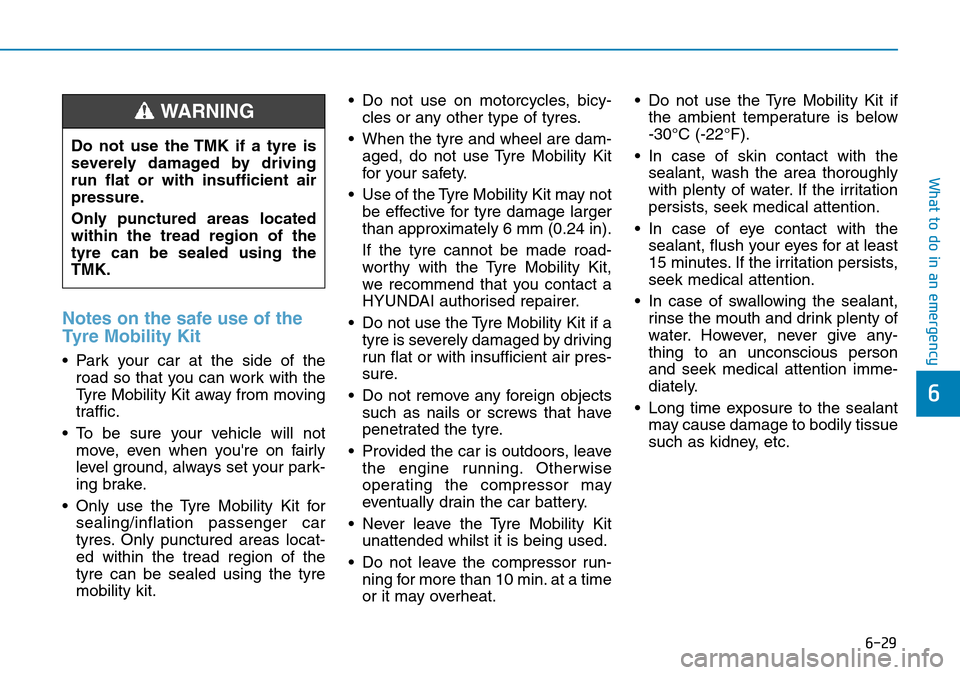
6-29
What to do in an emergency
6
Notes on the safe use of the
Tyre Mobility Kit
• Park your car at the side of theroad so that you can work with the
Tyre Mobility Kit away from moving
traffic.
• To be sure your vehicle will not move, even when you're on fairly
level ground, always set your park-
ing brake.
• Only use the Tyre Mobility Kit for sealing/inflation passenger car
tyres. Only punctured areas locat-
ed within the tread region of the
tyre can be sealed using the tyre
mobility kit. • Do not use on motorcycles, bicy-
cles or any other type of tyres.
• When the tyre and wheel are dam- aged, do not use Tyre Mobility Kit
for your safety.
• Use of the Tyre Mobility Kit may not be effective for tyre damage larger
than approximately 6 mm (0.24 in).
If the tyre cannot be made road-
worthy with the Tyre Mobility Kit,
we recommend that you contact a
HYUNDAI authorised repairer.
• Do not use the Tyre Mobility Kit if a tyre is severely damaged by driving
run flat or with insufficient air pres-
sure.
• Do not remove any foreign objects such as nails or screws that have
penetrated the tyre.
• Provided the car is outdoors, leave the engine running. Otherwise
operating the compressor may
eventually drain the car battery.
• Never leave the Tyre Mobility Kit unattended whilst it is being used.
• Do not leave the compressor run- ning for more than 10 min. at a time
or it may overheat. • Do not use the Tyre Mobility Kit if
the ambient temperature is below
-30°C (-22°F).
• In case of skin contact with the sealant, wash the area thoroughly
with plenty of water. If the irritation
persists, seek medical attention.
• In case of eye contact with the sealant, flush your eyes for at least
15 minutes. If the irritation persists,
seek medical attention.
• In case of swallowing the sealant, rinse the mouth and drink plenty of
water. However, never give any-
thing to an unconscious person
and seek medical attention imme-
diately.
• Long time exposure to the sealant may cause damage to bodily tissue
such as kidney, etc.
Do not use the TMK if a tyre is
severely damaged by driving
run flat or with insufficient air
pressure.
Only punctured areas located
within the tread region of the
tyre can be sealed using the
TMK.
WARNING
Page 392 of 497

6-30
What to do in an emergency
0. Speed- restriction label
1. Sealant bottle and label with speed restriction
2. Filling hose from sealant bottle to wheel
3. Connectors and cable for the power outlet direct connection 4. Holder for the sealant bottle
5. Compressor
6. ON/OFF switch
7. Pressure gauge for displaying the
tyre inflation pressure
8. Button for reducing tyre inflation pressure 9. Hose to connect compressor and
sealant bottle or compressor and
wheel
Connectors, cable and connection
hose are stored in the compressor
housing.
Strictly follow the specified sequence,
otherwise the sealant may escape
under high pressure.
Components of the Tyre Mobility Kit
OEL069020
Expired sealant
Do not use the Tyre sealant after
the sealant has expired (i.e.
pasted the expiration date on
the sealant container). This can
increase the risk of tyre failure.
WARNING
Sealant
•Keep out of reach of children.
•Avoid contact with eyes.
•Do not swallow.
WARNING
Page 394 of 497
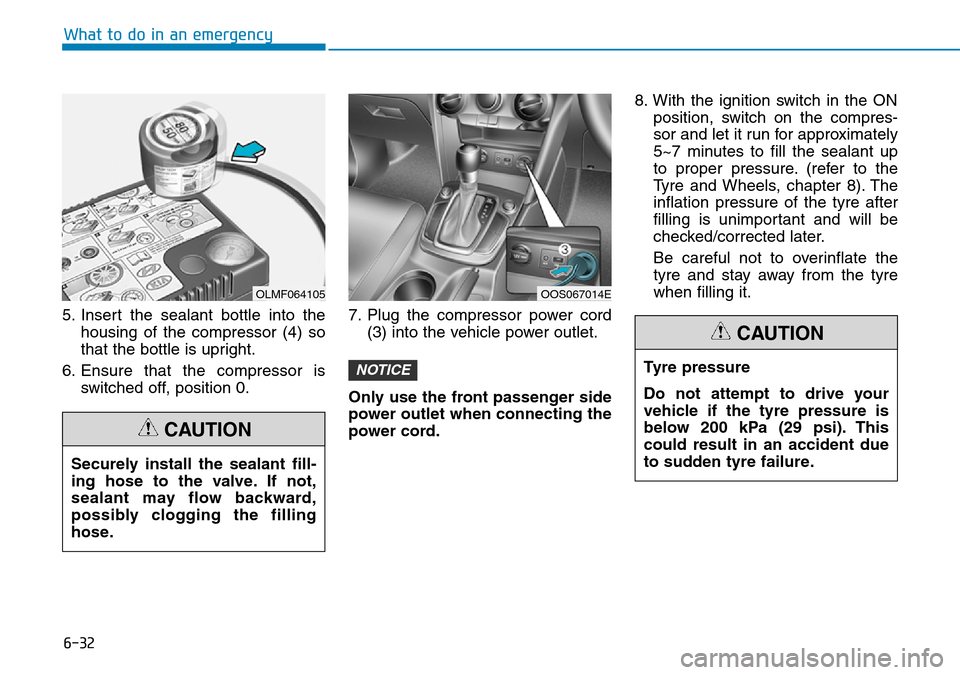
6-32
What to do in an emergency
5. Insert the sealant bottle into the housing of the compressor (4) so
that the bottle is upright.
6. Ensure that the compressor is switched off, position 0. 7. Plug the compressor power cord
(3) into the vehicle power outlet.
Only use the front passenger side
power outlet when connecting the
power cord. 8. With the ignition switch in the ON
position, switch on the compres-
sor and let it run for approximately
5~7 minutes to fill the sealant up
to proper pressure. (refer to the
Tyre and Wheels, chapter 8). The
inflation pressure of the tyre after
filling is unimportant and will be
checked/corrected later.
Be careful not to overinflate the
tyre and stay away from the tyre
when filling it.
NOTICE
OLMF064105
Securely install the sealant fill-
ing hose to the valve. If not,
sealant may flow backward,
possibly clogging the filling
hose.
CAUTION
OOS067014E
Tyre pressure
Do not attempt to drive your
vehicle if the tyre pressure is
below 200 kPa (29 psi). This
could result in an accident due
to sudden tyre failure.
CAUTION